Facemasks have been one of the principal weapons in our fight against the COVID-19 pandemic. The facemask is a barrier that helps contain the respiratory droplets when worn properly fully covers the nose and mouth. National public health agencies such as Health Canada and the Centers for Disease Control and Prevention (CDC, USA) strongly recommend using masks to contain the virus spread. There are two principal categories generally referred to as ‘masks’; Respiratory Protection and Source Control.
Respirators and Surgical Masks
A respirator is a protection device covering the user’s nose and mouth or the entire face or head. It helps to reduce the wearer’s exposure to contaminated air, such as respiratory droplets from a COVID-19 patient. The N95, technically classified as the filtering facepiece respirator, is the commonly used respirator.
A mask is a Source Control device that covers the nose and mouth of a person. It helps reduce the spread of respiratory droplets to others as the wearer talks, coughs, or sneezes. The commonly used surgical mask is a loose-fitting device compared to an N95 respirator.
Countries have different standards defining the performance of respirators and surgical masks. They are also regulated differently. For example, in the USA, the National Institute for Occupational Safety and Health (NIOSH), regulates N95 respirators using stringent test conditions. They even maintain a list of NIOSH-approved Filtering Face Respirators. Food and Drug Administration (FDA) regulates surgical masks. The ASTM F2100 standard defines the performance requirements.
So, the critical difference is that a respirator protects the wearer from contaminated air, whereas the source control (mask) protects others by containing droplets from those infected but may not know it.
They have one thing in common - both respirators and surgical masks are meant for single-use and are generally recommended to be discarded after that. However, during the initial stages of the pandemic due to a critical shortage of respirators, CDC recommended procedures to decontaminate and reuse N95 respirators.
Multiple-use masks
The standards and regulatory mechanisms for respirators and surgical masks evolved before the COVID-19 pandemic. The rapid spread of SARS-CoV2 necessitated widespread use of face-covering as a principal tool to slow the spread. They could not meet the surge in demand due to cost, supply shortage, artificial demand due to hoarding, etc. Public health agencies started providing broad guidelines for washable and reusable facemasks. A new type of product - fabric face mask emerged; it even quickly became a fashion accessory.
The American Society for Testing and Materials (ASTM) has recently established a new standard, ASTM F3502, for Barrier Face Coverings (the new technical term for fabric face covering). This establishes minimum mandatory criteria for design, performance, testing, labelling, and information to users. The rationale of this standard is not to stringently define the overall performance, but to provide a consistent baseline that allows comparison of product claims in terms of filtration efficiency, breathability, re-use potential, and leakage.
Surgical mask vs BFC
The common (blue) surgical mask does not have any fit requirement; it controls respiratory droplets from the wearer reaching the airspace around. Fabric masks compliant to ASTM F3502 require snug fitting. In addition to providing source control like surgical masks, their mandated filtration requirements ensure that they serve as a barrier for common pathogens in the airspace.
A significant difference is that the surgical masks are recommended to be discarded after a single use, whereas the BFCs can be washed and reused multiple times. There are mandatory test requirements after the specified number of washes. The manufacturer should also provide laundering instructions to the user. These requirements address one of the grave environmental challenges that emerged since the pandemic. An estimated 129 billion face masks are used globally every month. Approximately 3 million masks are discarded every minute. Barrier Face Coverings prevent COVID-19 spread while simultaneously minimizing microplastic pollution that emerged since the pandemic started.
